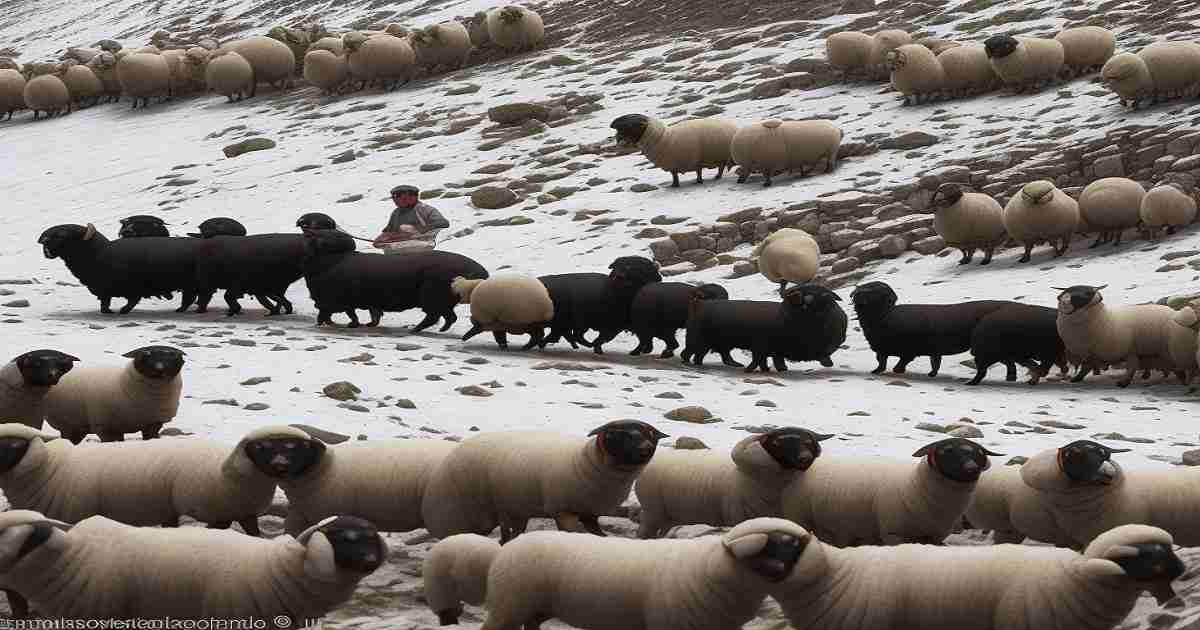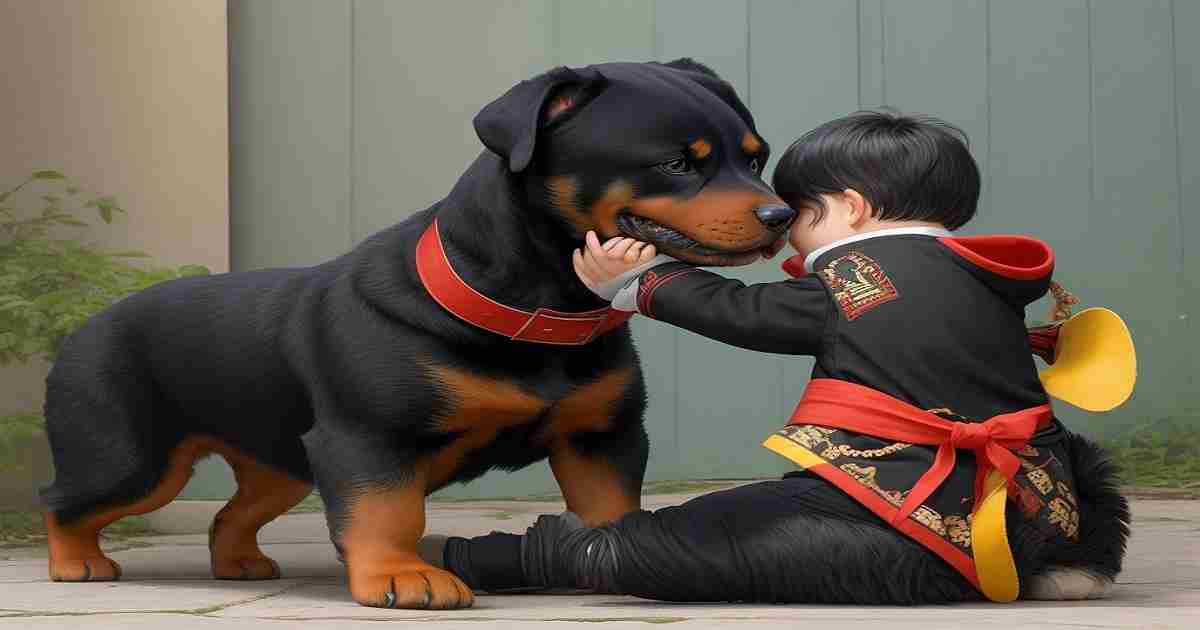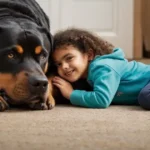Rottweilers rank among the most popular dog breeds globally, beloved for their intelligence, loyalty, and versatility.
But did you know there are two distinct variations of this incredible working dog – the Roman vs. Serbian Rottweiler?
While they share a common ancestry and many similarities, Roman and Serbian Rotties have unique characteristics setting them apart.
So if you’re contemplating adding one of these magnificent pups to your family, it’s essential to understand the differences.
This comprehensive guide will uncover everything you need to know to choose between these exceptional Rottweiler variations.
You’ll learn about their origins, appearance, temperament, exercise needs, suitability as family pets, working roles, health, grooming, and more.
Let’s get started unraveling the intricacies of these remarkable dogs!
Delving Into the Rich History of the Rottweiler Breed
Boasting a history spanning over 2000 years, Rottweilers descend from ancient Roman drover dogs used to herd cattle for the Roman army.
Their name derives from the small town of Rottweil in Germany, where these gutsy canines drove cattle to market through the middle ages.
Rotties accompanied Roman troops on campaigns across Europe, proving their worth as guard dogs and couriers.
Later they pulled carts, herded livestock, and protected homesteads. Rottweilers were among the earliest police, military, and service dogs.
Over time, localized breeding led to variations like the Roman Rottweiler and Serbian Rottweiler.
While their bloodlines clearly intersect, each strain boasts distinctive traits sculpted by their native regions. Let’s take a closer look at how they compare.
Spotlight On: Characteristics of the Roman Rottweiler
Originating in Italy, Roman Rottweilers retain the breed’s antiquity. They’re closer than Serbian Rotties to the original drover dogs of the Roman legions. Let’s explore their defining attributes:
Appearance: Sturdy and Imposing
Roman Rottweilers are noticeably larger and stockier with dense bone structure and muscles. Males stand 25-27 inches tall, weighing 110-135 pounds. Females reach 23-25 inches tall and 80-100 pounds.
They have broad skulls, black noses, dark almond-shaped eyes, and triangular ears. Their coats are straight, dense, and black with rust to mahogany markings. A Roman Rottie’s size and bearing oozes power and commands respect.
Temperament: Confident and Discerning
Fearless yet discerning guardians, Roman Rottweilers are vigilant and intolerant of threats.
Their self-assuredness requires extensive socialization. Exceedingly loyal and affectionate with family, they’re aloof with strangers.
Intelligent and eager to please, Roman Rotties need ample mental and physical stimulation.
Firm guidance channels their strength into an exceptional working dog. They excel at virtually any task.
Exercise: At Least 2 Hours Daily
To maintain their physique and happiness, Roman Rottweilers need over 2 hours of vigorous daily exercise. Long walks, hiking, running, and swimming satisfy their high energy and stamina. They thrive on action and adore interactive play.
As natural athletes built for work, Roman Rotties need both mental and physical challenges. Nose work, agility, carting, dock diving, or brisk training sessions provide healthy outlets for their exuberance.
Family Life: Protective Guardians
Despite their imposing presence, devoted Roman Rotties make wonderful family companions for experienced owners. Early extensive socialization ensures they distinguish friend from foe.
Roman Rottweilers lavish affection on “their” people while monitoring the homestead. They’re gentle caregivers of children but need supervision due to their size. Always alert, they’ll sound the alarm if anything seems amiss.
All About the Serbian Rottweiler
Bred for generations in Serbia, this variation developed alongside the Karakachan dog used by shepherds to guard livestock from wolves and bears. This ancestry shaped many Serbian Rottweiler traits.
Appearance: Lean and Rugged
Serbian Rotties have a noticeably longer neck and leaner build than their Roman counterparts.
Males stand 24-26 inches tall and weigh 88-106 pounds. Females range from 22-24 inches tall weighing 66-88 pounds.
They boast dark almond-shaped eyes, triangular hanging ears, and a long, coarse black coat with rust markings.
Their athletic frame suits their traditional role as hardy mountain dogs.
Temperament: Dominant and Discerning
Bred to independently manage livestock guarding duties, Serbian Rottweilers are bold and assertive.
They’re aloof with strangers and intolerant of perceived threats. Despite their ruggedness, Serbian Rotties are affectionate and loyal to their family.
Mentally sharp and eager to work, they need extensive training and socialization from an early age.
Serbian Rottweilers are attentive and single-minded when focused on a task.
Exercise: Up For Any Challenge
Serbian Rotties love strenuous activity. Long daily hikes, running, swimming, or backpacking keeps these tireless workers happy.
They relish canine sports like agility, tracking, herding trials, and competitive obedience.
Mental stimulation is equally crucial. Challenging interactive games and regular training sessions give their active minds an outlet. Serbian Rotties thrive when given a job to do.
Family Life: Cautious and Watchful
Despite their aloofness with outsiders, Serbian Rottweilers bond closely with their family.
They’re gentle and protective of children. However, their assertiveness necessitates training.
Early socialization helps Serbian Rotties live amicably with other pets. They’ll eagerly watch over your home, sounding the alert at anything suspicious. Wary of strangers, they’re devoted to their loved ones.
Side-By-Side: Key Differences in Appearance and Temperament
While they clearly share common ancestry, some key physical and behavioral differences help distinguish Serbian Rottweilers from Roman Rottweilers.
| Trait | Roman Rottweiler | Serbian Rottweiler |
| Size | Larger, stockier, more substantial bone and muscle mass | Leaner, leggier, lighter bone structure |
| Build | Thick neck, broad skull, robust | Longer neck, narrower skull, rangy |
| Coat | Thick, straight, and dense | Longer, coarse coat |
| Temperament | Confident, vigilant guardian. Aloof with strangers. | Dominant, assertive. Wary of outsiders. |
| Trainability | Eager to please. Responds best to positive reinforcement. | Independent thinker. Firm, consistent leadership needed. |
| Activity Level | Very high energy and stamina. | Tireless. Needs intensive exercise. |
The loyal yet discerning Roman Rottie makes an exceptional family guardian and working dog with proper training and socialization.
The bold Serbian Rottweiler excels at independent decision making, ideally suiting them for livestock guarding and protection work.
Nailing the Exercise and Training Needs of Each Variation
To channel their energy and instincts in healthy ways, both Rottweiler variations need ample tailored exercise and training. Here’s a closer look at their respective requirements:
Roman Rottweilers: Mental and Physical Stimulation
- Exercise: At least 2 hours daily of vigorous activity like running, hiking, swimming. Enjoy interactive play and dog sports.
- Training: Respond eagerly to positive reinforcement training. Practice commands daily. Thrive learning new skills.
- Mental enrichment: Provide puzzle toys, nose work, advanced obedience or trick training to challenge their intelligence.
- Socialization: Extensive, starting early. Ensure they can distinguish friend from threat. Continue socializing throughout life.
Serbian Rottweilers: A Job to Do
- Exercise: Long daily workouts – hiking, running, backpacking. Canine sports like agility, flyball, dock diving. Hard physical challenges.
- Training: Respond best to firm, fair leadership. Practice commands consistently. Independent thinkers, so training is ongoing.
- Mental enrichment: Interactive puzzle toys, scent work, “find it” games. Give them tasks and jobs to fulfill.
- Socialization: Start early and continue lifelong. Ensure they accept handling, grooming and commands from others. Monitor interactions.
Catering exercise and training to each variation’s strengths keeps these intelligent, energetic dogs focused and out of trouble. Work closely with a professional trainer for best results.
How Do These Rottweiler Variations Perform as Family Pets?
What about suitability as a family companion? Let’s compare how these Rottweiler variations measure up as pets:
Roman Rottweilers: Devoted Family Guardians
When properly socialized from an early age, Roman Rotties excel as family pets. They form close bonds and adore spending time with their loved ones.
Despite their protective instincts, they’re gentle and affectionate with children.
Naturally vigilant, they’ll alert you to anything suspicious, making Roman Rotties ideal watchdogs.
When raised with other pets, they typically accept them as part of their family “pack”.
Serbian Rottweilers: Bold and Affectionate
Serbian Rottweilers can thrive as family companions with extensive early socialization. Their wariness around strangers requires supervision when out in public. But with their own family, they’re sweet, gentle, and deeply loyal.
Their assertiveness demands an experienced owner providing fair, firm leadership. Well-socialized Serbian Rotties get along fine with children and other pets. They’re natural protectors who take their guarding role seriously.
For both variations, monitoring interactions with unfamiliar visitors, children, and pets is wise due to their impressive size and strength. But their devotion to “their” people makes Rottweilers wonderful family additions.
Putting Their Working Roles in the Spotlight
Rottweilers earned global popularity as the consummate working dog. Both strains carry on this tradition in occupations best matched to their temperament and talents.
Roman Rottweilers: Multipurpose Pros
The versatile Roman Rottweiler has the confidence and capability to conquer virtually any task. Their renowned roles include:
- Police, military, and guard dog
- Search and rescue
- Service dog for the disabled
- Herding and droving
- Hunting guide and retriever
- Competitive dog sports like Schutzhund
- Therapy work and emotional support
With proper socialization and training, Roman Rotties excel at many types of work due to their intelligence, athleticism, work ethic, and eagerness to please.
Serbian Rottweilers: Hard-Working Herders
Iron-willed and bold, Serbian Rottweilers carry on their forebears’ duties as livestock guardians and herders. Common occupations that showcase their talents include:
- Sheep, goat, and cattle herding
- Livestock guardian against predators
- Personal and property protection
- Police and security applications
- Search and rescue
- Competitive herding events
- Draft work like carting and sledding
Focused and assertive, Serbian Rotties thrive when given a job to do – especially work allowing independent decision-making.
Managing the Health Needs of Both Variations
All dogs have certain breed-specific health issues to consider. Here’s what to watch for in Roman and Serbian Rottweiler variations:
Roman Rottweilers tend to have fewer health problems due to better established breed standards and responsible breeding practices. Some conditions to screen for include:
- Hip and elbow dysplasia
- Eye issues like cataracts and progressive retinal atrophy
- Cardiac conditions including aortic stenosis
- Immune mediated diseases like hypothyroidism
Serbian Rottweilers face higher risks of certain orthopedic, neurological and cardiac conditions. Recommended health screens include:
- Evaluating hips and elbows for dysplasia
- Cardiac exam for subaortic stenosis
- Eye exam
- Testing for degenerative myelopathy
For both variations, work only with reputable breeders actively screening breeding stock. Follow your vet’s advice on tests and discuss any emerging issues. Proper diet, exercise and preventative care are also essential.
Grooming Basics for Both Variations
While short-haired, Rottweilers do shed and need regular grooming. Here are tips for basic care:
For Roman Rottweilers:
- Brush coat weekly using a slicker brush to remove dead hair
- Bathe monthly or as needed using a dog-friendly shampoo
- Trim nails monthly and check/clean ears weekly
- Brush teeth regularly with a vet-approved dog toothpaste
For Serbian Rottweilers:
- Brush coat twice weekly to keep their longer hair tidy
- Bathe every 4-6 weeks or as needed
- Check and clean ears weekly to avoid infections
- Trim nails monthly – walk on hard surfaces to help wear them down naturally
- Brush teeth routinely to promote gum health
Never shave a Rottweiler’s coat, even in summer. Regular brushing, bathing, nail and dental care keeps them looking and feeling their best.
Debunking Myths About These Exceptional Rottweilers
Despite their intimidating appearance, Rottweilers have many misconceptions unfairly surrounding them. Here’s the truth behind the myths:
Myth: Rottweilers are vicious dogs.
Fact: When properly trained and socialized, Rottweilers are gentle, loyal, and eager to please. Their protective nature demands responsible ownership.
Myth: Rottweilers don’t make good family pets.
Fact: Devoted to their families, Rottweilers are affectionate companions and guardians when socialized early. They adore children.
Myth: Rottweilers are too powerful and dangerous to control.
Fact: A well-trained, exercised Rottweiler who understands basic obedience cues is no more difficult to handle than any large breed.
Myth: Rottweilers are slow, dim-witted dogs.
Fact: Eager and intelligent, Rottweilers thrive when challenged mentally and physically. They’re highly trainable working dogs.
Myth: Rottweilers don’t require much exercise.
Fact: This energetic, athletic breed needs at least 2 hours of vigorous daily exercise and mental stimulation to stay fit and happy.
Don’t let unfair assumptions color your view of this exceptional breed. Work with reputable breeders and trainers to experience the Rottweiler’s true devoted, fun-loving nature for yourself.
Choosing Between These Outstanding Rottweiler Variations
Deciding between the Roman Rottweiler and Serbian Rottweiler means matching their traits with your lifestyle and expectations.
Best for families: The loyal Roman Rottweiler thrives when surrounded by their loved ones. Serbian Rotties can do well in homes with proper socialization.
Best for independent work: The dominant Serbian Rottweiler excels when given a job with solitary duties like livestock guarding.
Best for urban settings: The highly trainable Roman Rottweiler adapts better to city life. Serbian Rotties would prefer a rural setting.
Best for competitive dog sports: Eager to please and highly trainable, most Roman Rottweilers thrive in activities like agility, obedience and more.
Best for an active home: Both variations need ample exercise, but the Serbian Rottweiler has a higher activity level and endurance.
Talk honestly with breeders about whether the Roman or Serbian Rottweiler better fits your lifestyle and experience level. Then get ready for a decade of unwavering companionship!
Still Have Questions? Here Are Answers to FAQs About These Rotties
Q: What are the main differences between Roman and Serbian Rottweilers?
A: Roman Rottweilers are larger and stockier while Serbian Rotties are leaner. Romans have a shorter coat and can adapt better to family living. Serbian Rottweilers have more aggressive guarding instincts and require intensive exercise.
Q: Can a Roman Rottweiler live happily with a Serbian Rottweiler?
A: Yes – with proper socialization and training, Rottweiler variations can coexist amicably. Monitor play and interactions, provide separate beds/toys, and give each dog individual attention.
Q: Do these Rottweilers have different exercise needs?
A: Both need vigorous activity, but Serbian Rottweilers have a higher energy level and need more intensive exercise like. Here is a draft conclusion to wrap up the article:
Conclusion:
With their storied history, imposing presence, and versatility, it’s no wonder Rottweilers continue to rank among the world’s most popular dog breeds.
Both the Roman and Serbian variations of this exceptional working canine make loyal, capable companions and protectors.
By understanding the origins, physical attributes, temperament, exercise and training needs of each type, you can determine whether the confident Roman Rottweiler or independent-minded Serbian Rottweiler better matches your lifestyle.
While minor differences exist between these strains, sound health, extensive socialization, patient training and responsible ownership allows both to thrive as family guardians and working dogs.
Their affection for their people coupled with wariness of outsiders provides that perfect blend of companionship and protection.
Whether you choose a Roman or Serbian Rottweiler, you’ll gain a devoted friend for life when you commit to meeting their needs.
With their intelligence, athleticism, work ethic, and eagerness to please, Rottweilers prove why they deserve their place among the canine elite.












